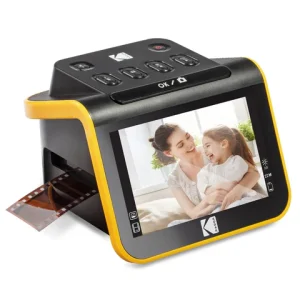Introduction (Does It Do What It Should)
 So, you want to hear a funny story? I was supposed to receive a product from HP that does essentially the same thing, but I was sent this instead. I was told to send it back, but then I said: “Not so fast. I’d like to test this out.” Yes, I told them I was doing this, and I don’t recall getting permission. Let’s hope that they approve.
So, you want to hear a funny story? I was supposed to receive a product from HP that does essentially the same thing, but I was sent this instead. I was told to send it back, but then I said: “Not so fast. I’d like to test this out.” Yes, I told them I was doing this, and I don’t recall getting permission. Let’s hope that they approve.
Anyway, the Slide N Scan is a very cool product from Kodak which allows you to take old slides or negatives, and save them to an SD card. From there, you have your memories and can save them to a computer, or wherever you want to keep them digitally.
That’s this product in a nutshell, and yes, it is strikingly similar to a product that I just reviewed from HP. You can see that article and video if you don’t believe me. Before I get to the similarities, I’ll talk about the differences.
First of all, the Kodak Slide N Scan includes an HDMI port which allows you to connect to a display or whatever is HDMI compatible. Yes, you remember when smartphones used to have that small HDMI port? That was kind of a phase.
The second difference is that the one from HP has a touchscreen, which would be a great benefit to the SLIDE N SCAN, really. As it is, it has a few buttons on top that allow the user to work it.
You can see in the video just how it works, especially when it comes to adjusting the color. If you have a slide, all you need to do is put it in this try that can open and close shut with a snap, and then slide (using this as a verb) the tray into the Slide N Scan. From there, you can look at the image and hit that big snooze-bar sized button on top to save it to the SD card. By the way, this thing will not work without an SD card.
It also requires a connection to something USB in order to work, and I don’t think you can just connect it to your computer and move files to it. By the way, there’s a button it this that will format the SD card, but don’t press that unless you really mean it, as I believe it takes some time for that formatting to happen. I don’t really know, because once I pressed it, and figured out that this is what it did later by reading the instructions, I stopped it from happening.
If you want this, head on over to the Kodak site and pay a price of about $189.99 to $224.99 for it.
Facts About The Company
I’m not certain who you would have to be to never have heard of Kodak. At this point, you could find more information about them from a history book than you would me.
There was a time when Kodak just meant photography, but since most of us have digital cameras on our mobile devices, the age of developing and getting prints is essentially over. I’m not certain how that affected the company, but let’s just put it this way: before 2010, Kodak had a huge booth at CES every year, but now, they really don’t. They do have some representation, though, and I believe that they have pivoted to the digital realm world of photography.
Just the Specs, Man!
Interface: USB 2.0
Image Sensor: 14.0 megapixels (4320×3252) 1/2.33′′ CMOS sensor
Resolution: 14MP/22MP (interpolation)
Supported Film Types: 50 mm Slides (135, 110, 126)
Color Negative Film (135, 110, & 126)
Black & White Negative Film (135, 110, & 126)
TV-Out Type: HDMI
External Memory Support: SD card 32GB
Power: From Computer USB Port, 5V/1A Power Adapter (not included), Power Bank
Dimensions: 5.27′′ D x 5.35′′ W x 3.74′′ H (95 x 136 x 134 mm)
Weight: 13.4 oz (380 grams)
What Does This Company Make?
I’m on the site right now, and I’m seeing cameras, printers (for photos), scanners, and projectors being represented.
Okay, Get To The Unboxing Already!
Maybe I Want It, But Is There Anything Else Like It? Maybe For A Lower Price? Please?
Well, I’m not certain of the price, but there is that one from HP.
Leave a Reply